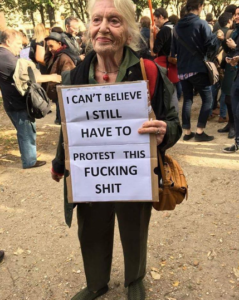
On November 8th, I taught Spanish class at NYU at 11am. It wasn’t 11:10 yet and I heard the word ¨nazi¨ twice, coming from a couple of students who, against the class´ rules, were speaking in English. I turned to look at them and they said, ¨Sorry! We´re just worried about the election”. We all laughed, that nervous kind of laugh that says deep inside we still hope everything´s going to be all right. I asked if they had voted yet, some said yes, some said later after school. Everyone was voting for Hilary, despite the fact that they dislike her so much. It was one of those days when you realize it´s a wonderful thing to live and work in a University.
I always thought it was possible for him to win. I kept telling those who didn’t think he had a chance, “You had Schwartzenegger for governor! You had Reagan for president!” Still, I didn’t want to believe that Clinton, who had worked all her life for this, would loose to someone so obscene, so grotesque, so absolutely ridiculous.
I also went to Ethnomusicology class in the afternoon. A friend was wearing a hat with a poker card that had Hilary on it, “It´s my lucky charm¨, she said. We all smiled and agreed to leave early, for the professor had yet to vote. I went training to the USA Shaolin Temple, it was full and everyone was feeling cheerful, excited, hopeful. Sifu said at some point, “bam! Like you´re beating Trump!”. More laughs and smiles. Someone joked about himself being elected president, “Nobody knows how it happened, but Sifu Shi Yan Ming was elected!” I wouldn’t mind having a Buddhist Shaolin monk for president. He would make everyone stretch their bodies and their minds.
But when we finished training, a girl picked up her iphone and said it: “Trump is ahead”. Silence. Sifu, who became a citizen just a few years ago, turned on the big screen of the temple and we all watched, paralyzed. He just kept sighing and saying ¨stupid people…stupid people…” I stayed and watched for a while. In the women´s changing room, someone was saying, “my father is a Russian immigrant, and he voted for Trump…all those people, Mexican, Russian, Cuban immigrants, they voted for him…I don’t understand”.
I felt the need to go back home to my boyfriend, who was probably already watching how things got worse. We sat together for a while. I went to bed at midnight, broken and tired. Tony stayed up all night, writing about what he thinks will happen, what he wants to do, what must be done. The next day my first thought was that it had all been a nightmare. Then I went into the day. My students had an exam, one of them wrote to say she was so depressed that she needed to see a therapist. When I got to the classroom I said, “I haven’t been deported yet, so you still have an exam”. They laughed a very different kind of laugh, a “we´re all together in this nightmare” laugh. I immediately see them in a different light. The Muslim, the Jew, the Hispanic. The Women, oh yes, the Women with a capital W. How must they see me, I think, how do I look to them today, the Mexican professor. We are all wearing our tag.
In my next class, a white student was crying. A Trinidadian girl just said it: “this just shows you how this country is not at all about freedom, and democracy, and all that…you´re all welcome to live in Trinidad if you have to.” The shame of the Americans was so tangible when they heard her, they didn’t have an answer, and yet somehow we all shared the shame. “You´re all welcome to Mexico too, if you can jump over the wall”, I said, and we all laughed, and began the class as best as we could.
Three of my students came to my office afterwards. A black girl was so angry at those who voted third party candidates, we laughed bitterly at their choice. She hated Hilary, and still voted for her, she felt that she had to. An Indian girl said she has lived here for a long time, but she will never again say that she´s from here.
Late in the afternoon I met for tea with Karin Coonrod, a theater director, and Sue Mingus, Charles Mingus´ widow, at Sue´s apartment, close to Time Square. We share our anger and disappointment. Karin says she wants to contact Hilary and do something together with her, to present a theater play she wrote about Queen Elizabeth, Texts and Beheadings, a play that shows how difficult for a woman is to deal with the game of power without getting your head cut off. Sue says she´s been playing a game of her own with some of the musicians in the Mingus Big Band, changing the lyrics of “Fables of Faubus”, which Charles wrote about governor Faubus when he didn’t wanted to integrate schools in Arkansas in the 50´s. “We changed those lyrics to Donald Trump”, Sue says. What a wonderful game, I think, to bring that song with such irony and humor to our present day, and I can already hear it in my head.
– Tell me someone who´s ridiculous, Dannie.
– Donald Trump!
– Why is he so sick and ridiculous?
– He hates Women, Mexicans, Muslims, Jews!
– Then he’s a fool! Boo!
Nazi Fascist supremists! Boo! Ku Klux Klan!
We leave Sue´s apartment. I go home to my white, Jewish, American boyfriend in the afternoon for a while. He tells me how much we should fear the people that will come with Trump, the ones who will destroy the environment, who will take away human rights, the ones who will lock the democrats out of the White House forever if we let them. And my mind´s already singing with him:
– Name me a handful that’s ridiculous, Tony.
– Giuliani, Christie, Mnuchin, Welch
– Why are they so sick and ridiculous?
– Two, four, six, eight:
They brainwash and teach you hate!
I walk through Union Square and I see someone is projecting in one of the buildings an image of Trump in black and white, followed by a list of adjectives that suit him well: “Ego Maniac. Xenophobe. Misogynistic. Entitled…” I feel like I´m in some futuristic movie, where the image of the tyrant follows you everywhere. I had dinner with a Spanish friend at a Mexican restaurant in Brooklyn. Her company is healing, and part of it is because she knows the power of humor. But tonight she also gets very serious, ¨Trump doesn’t get inside my house! And my house is Spain, and is France, and is Mexico all at once!”. I feel annoyed at the two white waiters who seem particularly condescending tonight to the two Spanish-speaking women. I feel as if they had done something to me, something personal. I try not to feel these emotions, and yet, there they are. I´m nice to them and leave a tip. Carmen and I walk to the subway, we part and I feel a little less safe on my own, on the train.
The stories of violence find us the next day. Even here, in the University, were we used to feel safe. And there´s lots to come. I think again of that fierce black student of mine, and how when they asked her if she was going to the protest, she said, “No, man, today I just want to go to church with my family and pray.” And I hear Mingus again in my head, with this “Fables of Trump” version I got now:
“Oh, Lord, don’t let them shoot us…
Oh, Lord, don’t let them stab us…”












